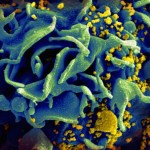wheat
Scientists use a 'gene gun' to insert a gene from a flowering plant called rockcress into the cells of wheat seeds. The genetically modified wheat became more resistant to a fungus called take-all, which in real life can cause "a 40-60% reduction in wheat yields."
T-cells from six HIV+ patients were removed from their bodies, treated with a zinc-finger nuclease designed to snip a gene out of the cell's DNA, and put back in the patients. Removal of the gene mimics a naturally occurring mutation which confers resistance to the HIV virus. But only 25% of the treated cells showed…
Ok, that's not quite the headline at the New York Times, but close enough. Yes, the latest Oxfam figures that came out today say that we're back under 1 billion starving people. But yes, those figures were compiled before the Pakistani Floods, and before the 5% rise in food prices driven by the Russian wheat crisis.
The number of hungry people fell to 925 million from its all-time high of 1.02 billion in 2009, with much of the improvement tied to income growth in the Asia-Pacific region as well as a 40 percent decline in food prices from their 2008 peak.
The hunger number remains "…
Longtime readers of ye olde blogge will remember that we talked a lot about wheat stem rust and other wheat diseases in the last few years, since Ug99 began to devastate Kenyan wheat production, and then again as it appeared in Yemen and Iran, but I don't think I've posted anything about the track of wheat stem rust since I moved over to Science Blogs. But the Economist has a good introductory article on the issue this month that is worth reading for those of you who haven't been following this.
The new variant is called Ug99: Ug for its country of origin; 99 for the year it was confirmed.…
I was trawling the USGS photo archive for upcoming Friday Rock Blog candidates when I came across this scanning electron micrograph of wheat. It's from a gargantuan volume published in 1981, full of initial reports about the eruption of Mt. St. Helens.
Why is there a picture of wheat in a book about a volcano?
It turns out people were curious about how quickly material from the ash would be incorporated into the soil nutrient supply, and particularly into crops. So a month after the eruption, USGS scientists sampled wheat and soil from fields that had been ashed on.
The answer? Wheat from…
